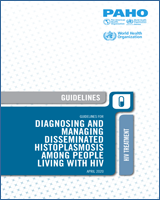Abstract
Background
Disseminated histoplasmosis is a serious fungal infection affecting people with advanced HIV. The optimal treatment regimens are unclear.
Objectives
Objective 1 – induction: to compare the efficacy and safety of initial therapy with liposomal amphotericin B versus initial therapy with alternative antifungal agents.
Objective 2 – maintenance: to compare the efficacy and safety of maintenance therapy with 12 months of oral antifungal treatment versus shorter durations.
Objective 3 – antiretroviral therapy: to compare the outcomes of early versus delayed initiation of antiretroviral therapy.
Search methods
We searched the Cochrane Infectious Diseases Group Specialized Register; Central Register of Controlled Trials (CENTRAL), published in the Cochrane Library; MEDLINE (PubMed, from 1966 to the present); Embase (OVID, from 1947 to the present); Science Citation Index Expanded (SCI-EXPANDED, from 1900), Conference Proceedings Citation Index-Science (CPCI-S, from 1900), and BIOSIS Previews (from 1926). We also searched the WHO International Clinical Trials Registry Platform (http://www.who.int/ictrp/search/en), ClinicalTrials.gov, and the ISRCTN registry (www.isrctn.com) to identify ongoing studies.
Selection criteria
We evaluated studies assessing the use of liposomal amphotericin B and alternative antifungal agents for induction therapy; studies assessing the duration of antifungal agents for maintenance therapy; and studies assessing the timing of antiretroviral therapy. We included randomized controlled trials, single-arm trials, prospective cohort studies, and single-arm cohort studies.
Data collection and analysis
Two review authors assessed eligibility and the risk of bias, extracted data and assessed the certainty of evidence. We used the ROBINS-I tool to assess the risk of bias in non-randomized studies. We summarized dichotomous outcomes using relative risks (RR).
Main results
We identified 17 individual studies, 10 of which could inform our review objectives. We found one randomized controlled trial that compared liposomal amphotericin B to deoxycholate amphotericin B. Compared with deoxycholate amphotericin B, liposomal amphotericin B may have higher clinical success rates (RR 1.46, 95% confidence interval (CI) 1.01–2.11, 80 participants, one study, low-certainty evidence) and lower rates of nephrotoxicity (RR 0.25, 95% CI 0.09–0.67, 77 participants, one study, high-certainty evidence) (29).
We found very-low-certainty evidence to inform comparisons between amphotericin B formulations and azoles for induction therapy.
We found very-low-certainty evidence to inform whether early versus deferred antiretroviral therapy is preferable in disseminated histoplasmosis.
Authors’ conclusions
Liposomal amphotericin B appears to be preferable to deoxycholate amphotericin B for treating people living with HIV for disseminated histoplasmosis in areas where it is available. Since there is very-low-certainty evidence to inform other treatment choices, we recommend further prospective research.
Liposomal amphotericin compared with amphotericin deoxycholate for induction therapy of progressive disseminated histoplasmosis
Population: adults with HIV and progressive disseminated histoplasmosis
Settings: endemic areas
Intervention: induction therapy with liposomal amphotericin B
Comparison: amphotericin B deoxycholate
View in own window
| Outcomes | Illustrative comparative risksa (95% CI) | Relative effect (95% CI | Number of participants (studies) | Certainty of the evidence (GRADE) | Comments |
|---|
| Assumed risk | Corresponding risk |
|---|
| Amphotericin B deoxycholate | Liposomal amphotericin B |
|---|
| Clinical success | 560 per 1,000 | 818 per 1,000
(566 to 1000) | RR 1.46
(1.01–2.11) | 80
(one study) | ⊕⊕⊝⊝
LOW
Due to imprecisionc | Liposomal amphotericin B may have higher clinical success rates than amphotericin B deoxycholate. |
| Death | 125 per 1,000 | 19 per 1,000
(3 to 173) | RR 0.15
(0.02–1.38) | 77
(one study) | ⊕⊕⊝⊝
LOW
Due to imprecisiond | Treatment with liposomal amphotericin B may result in lower mortality than treatment with amphotericin B deoxycholate. |
| Safety outcomes: nephrotoxicity | 375 per 1,000 | 94 per 1,000
(34 to 251) | RR 0.25
(0.09–0.67) | 77
(one study) | ⊕⊕⊕⊕
⊕⊝⊝⊝
HIGH | Treatment with liposomal amphotericin B results in lower rates of nephrotoxicity than treatment with amphotericin B deoxycholate; this is supported by the findings of a Cochrane review that reports moderate-certainty evidence.b |
| Safety outcomes: drug discontinuation | 83 per 1,000 | 19 per 1,000
(2 to 198) | RR 0.23
(0.02–2.38) | 77
(one study) | ⊕⊝⊝⊝
⊕⊕⊝⊝
VERY LOW
Due to imprecision and risk of biase | We do not know whether treatment with liposomal amphotericin B leads to fewer treatment discontinuations than amphotericin B deoxycholate. |
- a
The basis for the assumed risk (such as the median control group risk across studies) is provided in footnotes. The corresponding risk (and its 95% confidence interval) is based on the assumed risk in the comparison group and the relative effect of the intervention (and its 95% CI).
- b
Botero Aguirre
JP, Restrepo Hamid
AM. Amphotericin B deoxycholate versus liposomal amphotericin B: effects on kidney function. Cochrane Database Syst Rev
2015;(11):CD010481. [PMC free article: PMC10542271] [PubMed: 26595825]
CI: confidence interval; RR: risk ratio.
GRADE Working Group grades of evidence
High certainty: further research is very unlikely to change our confidence in the estimate of effect.
Moderate certainty: further research is likely to have an important impact on our confidence in the estimate of effect and may change the estimate.
Low certainty: further research is very likely to have an important impact on our confidence in the estimate of effect and is likely to change the estimate.
Very low certainty: we are very uncertain about the estimate.
- c
Downgraded by 2 for very serious imprecision: the confidence interval meets the line of no effect and is based on very few events (73 participants, one randomized controlled trial).
- d
Downgraded by 2 for very serious imprecision: the confidence intervals are wide and cross the line of no effect;
- e
Downgraded by 1 for serious risk of bias (due to unclear reporting criteria) and 2 for very serious imprecision (the confidence intervals are wide and cross the line of no effect).

